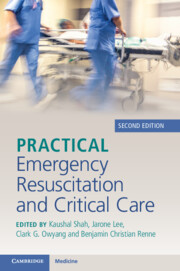Book contents
- Practical Emergency Resuscitation and Critical Care
- Practical Emergency Resuscitation and Critical Care
- Copyright page
- Contents
- Contributors
- Preface
- Section 1 General Critical Care
- Section 2 Infectious Disease Emergencies
- Section 3 Neurological Emergencies
- Section 4 Cardiovascular Emergencies
- Section 5 Respiratory Emergencies
- Section 6 Gastrointestinal Emergencies
- 28 Gastrointestinal Bleeding
- 29 Abdominal Aortic Aneurysms
- 30 Fulminant Hepatic Failure
- 31 Acute Mesenteric Ischemia
- 32 The Surgical Abdomen
- 33 Abdominal Compartment Syndrome
- Section 7 Renal Emergencies
- Section 8 Hematology–Oncology Emergencies
- Section 9 Endocrine Emergencies
- Section 10 Environmental Emergencies
- Section 11 Trauma
- Section 12 End of Life
- Index
- References
30 - Fulminant Hepatic Failure
from Section 6 - Gastrointestinal Emergencies
Published online by Cambridge University Press: 02 November 2023
- Practical Emergency Resuscitation and Critical Care
- Practical Emergency Resuscitation and Critical Care
- Copyright page
- Contents
- Contributors
- Preface
- Section 1 General Critical Care
- Section 2 Infectious Disease Emergencies
- Section 3 Neurological Emergencies
- Section 4 Cardiovascular Emergencies
- Section 5 Respiratory Emergencies
- Section 6 Gastrointestinal Emergencies
- 28 Gastrointestinal Bleeding
- 29 Abdominal Aortic Aneurysms
- 30 Fulminant Hepatic Failure
- 31 Acute Mesenteric Ischemia
- 32 The Surgical Abdomen
- 33 Abdominal Compartment Syndrome
- Section 7 Renal Emergencies
- Section 8 Hematology–Oncology Emergencies
- Section 9 Endocrine Emergencies
- Section 10 Environmental Emergencies
- Section 11 Trauma
- Section 12 End of Life
- Index
- References
Summary
Fulminant, or acute, hepatic failure is defined as severe hepatocyte dysfunction resulting in rapid elevation of aminotransferases, encephalopathy, coagulopathy and multiorgan failure in an otherwise healthy individual without preexisting liver disease. Acute liver failure (ALF) has an incidence of 1–2/100,000 people in the United States or approximately 3,000–6,000 cases per year with nearly 30% of patients requiring a liver transplantation. ALF is fundamentally different and should not be confused with acute or chronic liver failure or decompensated cirrhosis, as the etiology of ALF is the most important determinant of transplant-free survival.
Keywords
- Type
- Chapter
- Information
- Practical Emergency Resuscitation and Critical Care , pp. 279 - 292Publisher: Cambridge University PressPrint publication year: 2023

